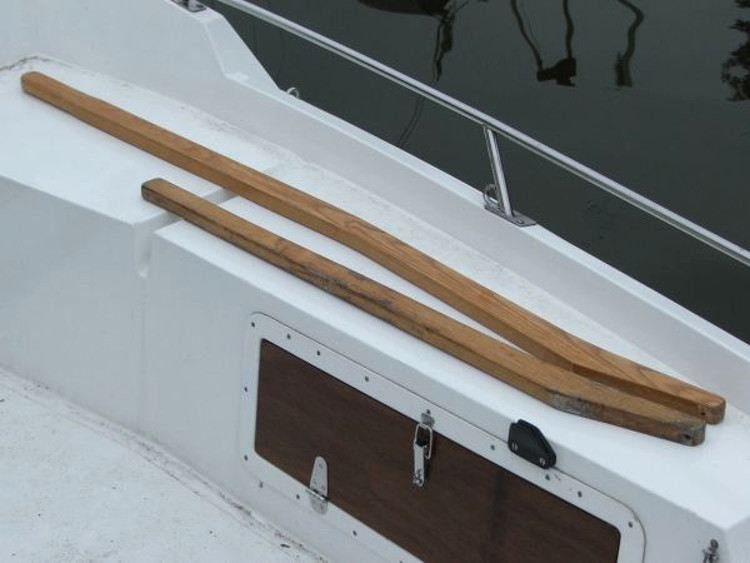Page updated: 22 November 2011
 Long Tiller - Single Handed
Long Tiller - Single Handed
A long tiller, such as that described below, significantly affects the capacity of the cockpit so should be considered only for use when single-handing or when two up and in light airs that do not require helm and crew to sit on the same side. It was designed for use on a boat with the standard Reedcraft jib cleats and jib, so may have less benefit for Moore's boats and those using a genoa.
On Reedcraft boats the jib cleats are mounted on small blocks of wood either side of the cabin door. The arrangement works well when there is crew to operate the jib. When single-handed you need arms the length of a gorilla's to reach both the tiller and jib sheets. Moores partly solved the problem by fitting winches on the cabin side extensions. However, so few of Moore's boats retain their original fittings unchanged, it must be concluded that there are other disadvantages to that design.
Greg Chapman recognised that to sit closer to the cabin he needed a longer tiller. Sitting further forward not only enables the helm to manipulate the jib sheets with ease, it also helps to lift the transom out of the water, reducing drag, and places the helm near the widest part of the boat so his weight is more effective in keeping the boat upright in a good breeze. Wanting something more solid and appropriate to a yacht he decided against fitting a dinghy-style extension and made a complete new tiller.

As can be seen in the picture, his new tiller is angled in the same way as the standard tiller where it fits into the rudder. The first angle was retained so the tiller did not foul the cockpit benches, but with the extra length it needed an opposite bend if it was not to rise too far to be at an uncomfortable working height. The second bend was made where the scuff marks appear on the underside of the standard tiller, those found where the standard tiller hits the cockpit benches.
The angle for the second bend was determined by measuring the height of the forward end of the standard tiller when it was propped up so that the underside of the short end was flat on the floor. The new tiller was not to rise higher than this.
In use, Greg reports that his calculation for the second bend didn't allow for the fact that the shorter lower face is not completely horizontal when fitted into the rudder socket, so it is perhaps a couple of inches higher than he intended. However, he is entirely happy with it in use.
 Short Tiller - Used
when Docking
Short Tiller - Used
when Docking
While some owners may find a long tiller useful another reports the use of a short tiller when manoeuvring in tight spaces. The photo below shows the short tiller alongside the standard tiller.

Describing its use the owner said:
I use the short tiller only when entering Hickling Staithe. I have to make a very tight 360° turn to Port to get onto my mooring I am sitting aft on the Stb side to control the O/B motor and my legs get in the way of the standard tiller when going hard to Pt. Using the short tiller the problem doesn't exist. I don't unship the rudder until I am on the mooring to avoid bringing the wet rudder inboard.
